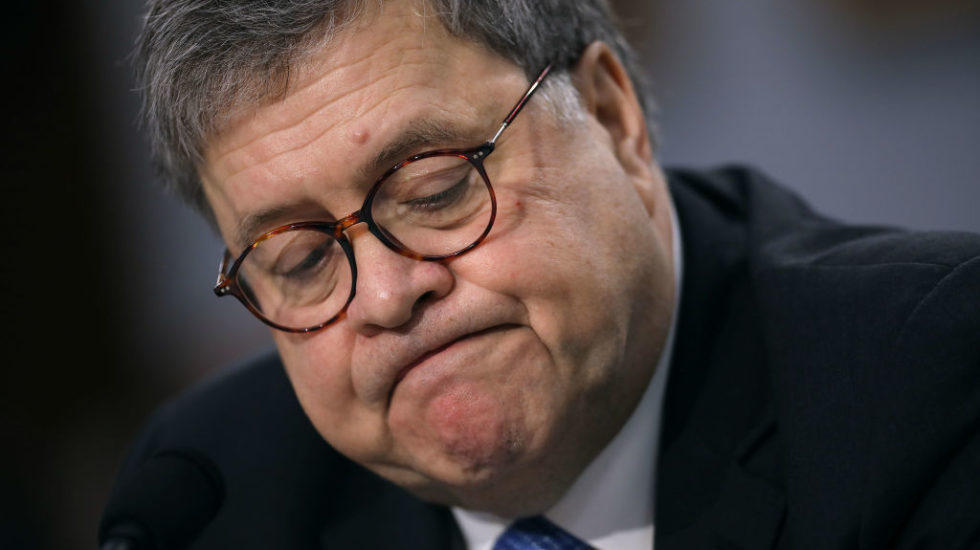The most dangerous person in American may not be Donald Trump. Attorney General William Barr has used his formidable legal skills to promote and weaponize Trump’s lies. Last week, Trump vested Barr with unprecedented power to wreak even more havoc on the truth. And it may make Barr the most dangerous person in the country, as recent additions to the Trump-Russia Timeline demonstrate.
Barr Now Controls Public Access to Key Facts
Mar. 24, 2019: Barr’s letter to Congress (and the public) uses misleading excerpts of sentence fragments from special counsel Robert Mueller’s report to declare Trump “not guilty” of obstructing justice. Barr’s deception fuels Trump’s “no collusion/no obstruction” lies about Mueller’s conclusions.
Apr. 9: Mueller’s report is still unavailable to Congress and the public. Testifying before a House committee, Barr says he doesn’t know the basis for news reports that members of Mueller’s team are unhappy with his Mar. 24 summary. He doesn’t disclose Mueller’s Mar. 27 letter complaining to Barr about the summary; Congress and the public are unaware of it.
Apr. 18: The release of a redacted version of Mueller’s report reveals that Barr misled Congress and the public about its findings and conclusions. Within a month, more than 900 former federal prosecutors who served under both Republican and Democratic administrations sign an open letter saying that, but for the fact that Trump is president, he would be facing “multiple felony charges for obstruction of justice” based on the facts in Mueller’s report.
Apr. 30: The Washington Post publishes Mueller’s Mar. 27 letter to Barr, which memorializes Mueller’s concern that Barr’s summary “did not fully capture the context, nature, and substance of this Office’s work and conclusions.” The result, Mueller wrote, “is public confusion about critical aspects of the investigation.” The Post awards Barr “Three Pinocchios” for misleading Congress in early April.
May 23: At Barr’s urging, Trump gives him unprecedented power over the entire US intelligence community’s most closely guarded secrets and orders all agencies to cooperate with him. In connection with the origins of the Trump-Russia investigation, Barr gains the unprecedented power to pick and choose which secret documents to declassify. But he can also select which documents not to declassify. That means he has complete control over what the public sees, hears, and believes about how the probe began. The discredited suggestion that the FBI was “spying” on his campaign began as a baseless Trump distraction from the investigation itself. In Barr’s hands, it’s now a potent weapon against Trump’s enemies.
Will Truth Survive?
Mueller’s report already answers the question Barr now revisits: How did the Trump-Russia investigation begin?
“On May 6, 2016, 10 days after…meeting with [Joseph] Mifsud, [Trump campaign adviser George] Papadopoulos suggested to a representative of a foreign government that the Trump Campaign had received indications from the Russian government that it could assist the Campaign through the anonymous release of information that would be damaging to Hillary Clinton. fn 465.”
“fn 465: This information is contained in the FBI case-opening document and related materials… The foreign government conveyed this information to the US government on July 26, 2016, a few days after WikiLeaks’s release of Clinton-related emails. The FBI opened its investigation of potential coordination between Russia and the Trump Campaign a few days later based on that information.” (Vol. I. p. 89)
None of that matters now. Barr is already reinforcing Trump’s lie that the investigation began as an effort to “spy” on his campaign. Although Trump’s chosen FBI director, Christopher Wray, has rejected that Trump talking point, Barr has embraced the word “spy” and Trump loves it. Barr’s willingness to perpetuate this and other false narratives — including the incorrect claim that Mueller found “no collusion” between Russia and the Trump campaign — makes Barr’s power over information all the more dangerous.
End Game?
On the day of Trump’s unprecedented delegation of power to Barr, Trump made comments that too many have dismissed as his typical bombastic rhetoric. But often that rhetoric is merely testing public reaction and morphs into troubling reality.
During a press conference at which he asked staffers to deny press reports that he’d become unhinged the previous day at a meeting with House Majority Leader Nancy Pelosi (D-CA) and Senate Minority Leader Chuck Schumer (D-NY), Trump said that some people were guilty of treason.
Asked to name them, Trump added, “I think a number of people. They have unsuccessfully tried to take down the wrong person. If you look at [James] Comey, if you look at [Andrew] McCabe, if you look at probably people higher than that, if you look at [Peter] Strzok, if you look at his lover, Lisa Page, his wonderful lover.”
Later that evening, Corey Lewandowski — who remains a close Trump confidant— appeared on Fox News. He said that former Vice President Joe Biden was behind the Steele Dossier and that Comey, McCabe, Strzok, and Page will all be on trial by March or April of 2020.
Treason is a capital offense. Trump wants more than just to investigate career law enforcement officers who were simply doing their jobs in 2016. He wants to execute them. And he has William Barr shaping the public’s view of his prosecutions.
This is the seventh in a series of posts by Steven J. Harper on the Mueller report. The first six installments are available here, here, here, here, here, and here. Steve is the creator and curator of the Trump-Russia Timeline appearing at Dan Rather’s News & Guts and at Just Security. He’s an attorney, adjunct professor at Northwestern University Law School, and author of four books, including Crossing Hoffa — A Teamster’s Story (Chicago Tribune “Best Book of the Year”) and The Lawyer Bubble — A Profession in Crisis. He blogs at The Belly of the Beast. Follow him on Twitter (@StevenJHarper1).
This post contains opinion and analysis.
